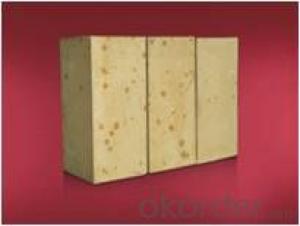Silica Brick - China Manufacture
- Loading Port:
- China Main Port
- Payment Terms:
- TT OR LC
- Min Order Qty:
- -
- Supply Capability:
- -
OKorder Service Pledge
OKorder Financial Service
You Might Also Like
Specifications
1.low thermal expansion,
2.high cold crushing strength,
3.low reheating linear change
Advantage:Our Refractory Brick: with high refractoriness and mechanical behavior under high temperature,Refractory brick is the necessary material of high- temperature service, mainly use for industrial furnaces and kilns and thermal equipments.
Type:We can supply High Alumina Bricks, Fireclay Bricks, Low Porosity Fireclay Bricks, Mullite Bricks, Corundum Bricks, AZS Bricks, Magnesite Bricks, Zircon Bricks,insulating Bricks etc.
Application: they are widely used in the metallurgy, steel, alumina, cement etc industry.
Index Item | Silica Brick for Cokeoven | |||
JG-94 | LJG-95 | LJG-93A | LJG-93B | |
SiO2 % ≥ | 94 | 95 | 93 | 93 |
Al2O3 % ≥ |
|
| 1.5 | 1.5 |
Fe2O3 % ≤ |
|
| 2.0 | 2.0 |
Refractoriness under load ≥ | 1650 | 1660 | 1650 | 1650 |
A.P. % ≤ | 22 | 22 | 22(23) | 24(25) |
C.C.S (Mpa) | 29.4 | 35 | 35(30) | 30(25) |
True density (g/cm3) ≤ | 2.35 | 2.34 | 2.34 | 2.35 |
Theruomal expansion ≥ |
| 1.25 | 1.25 | 1.25 |
Linear change | 0.2 | +0.2 |
|
|
Bulk density (g/cm3) ≥ |
|
|
|
|


- Q: Physical solid waste disposal
- Too much addition will reduce the refractory and mechanical strength, increase porosity, so the amount of waste brick should not be too much.
- Q: Because of the recent relates to this industry, by way of learning to name for all raw materials, I hope knowledgeable friends exhibitions, thank you.
- Classification of chemical components of refractory materialsAccording to the chemical characteristics of refractory raw materials can be divided into acidic refractory materials, such as silica, zircon etc.; neutral refractory raw material, such as corundum, bauxite, mullite (acidic) (acidic), Ge (alkaline) iron and graphite; alkaline refractory materials, such as magnesite, dolomite, magnesium sand calcium sand.
- Q: Why will expand when heated brick
- In the process of SiO2 drying, the four crystalline transformation points of 117, 163, 180~270 and 573 DEG C are found, among which the volume expansion caused by the 180~270 is the largest.
- Q: Semisilica brick interpretation
- High temperature volume stability. Volume change is small.
- Q: Semisilica brick, clay brick, high alumina brick and what is the difference?
- This is a kind of refractory material is divided into three types: semisilica brick (A12O315 ~ 30%), clay brick (A12O330 ~ 48%), high aluminum brick (A12O3>48%).
- Q: Can iron oxide be used as refractory material?
- Is widely used in this area. Mentioned refractory material of high school textbooks generally refers to three two aluminum oxide (alumina), alumina is also used as a refractory material, refractory crucible, porcelain, artificial gemstones.
- Q: The high thermal conductivity of silica brick and traditional brick what is the difference?
- Tridymite content high thermal conductivity silica brick is 70%, tridymite content of traditional brick is 60%, tridymite content high thermal conductivity of silica brick than tridymite high content of 10% traditional brick,
- Q: High temperature refractory material?
- Many kinds of refractory materials, usually by refractoriness level is divided into ordinary refractory materials (1580 to 1770 DEG C), advanced refractories (1770 to 2000 DEG C) and special refractories (more than 2000 DEG C); according to the chemical characteristics into acid refractory material, refractory materials and basic refractory materials. In addition, the refractory material used for special occasions.Now the definition of refractory materials, has not only depends on whether the refractoriness at 1580 DEG. Refers to the current refractories used in metallurgy, petrochemical, cement, ceramics and other production equipment with inorganic non-metallic materials.
- Q: Physical solid waste disposal
- The amount of addition is related to the shape and weight of the brick. The bricks can be added to 20% weight less than 25kg; bricks above 25kg can be added to 30%; for the specific type of brick can be added 30%. into waste silica brick should pay attention to this problem
- Q: The formula in the refractory brick, and firing curve, who knows?
- Add 1.8-2.2% of the total weight of the main raw material, and then add lime milk, rolling for 10-15 minutes, and finally add pulp, rolling for 10-15 minutes, out of the mill, forming billet.
Send your message to us
Silica Brick - China Manufacture
- Loading Port:
- China Main Port
- Payment Terms:
- TT OR LC
- Min Order Qty:
- -
- Supply Capability:
- -
OKorder Service Pledge
OKorder Financial Service
Similar products
Hot products
Hot Searches
Related keywords
























